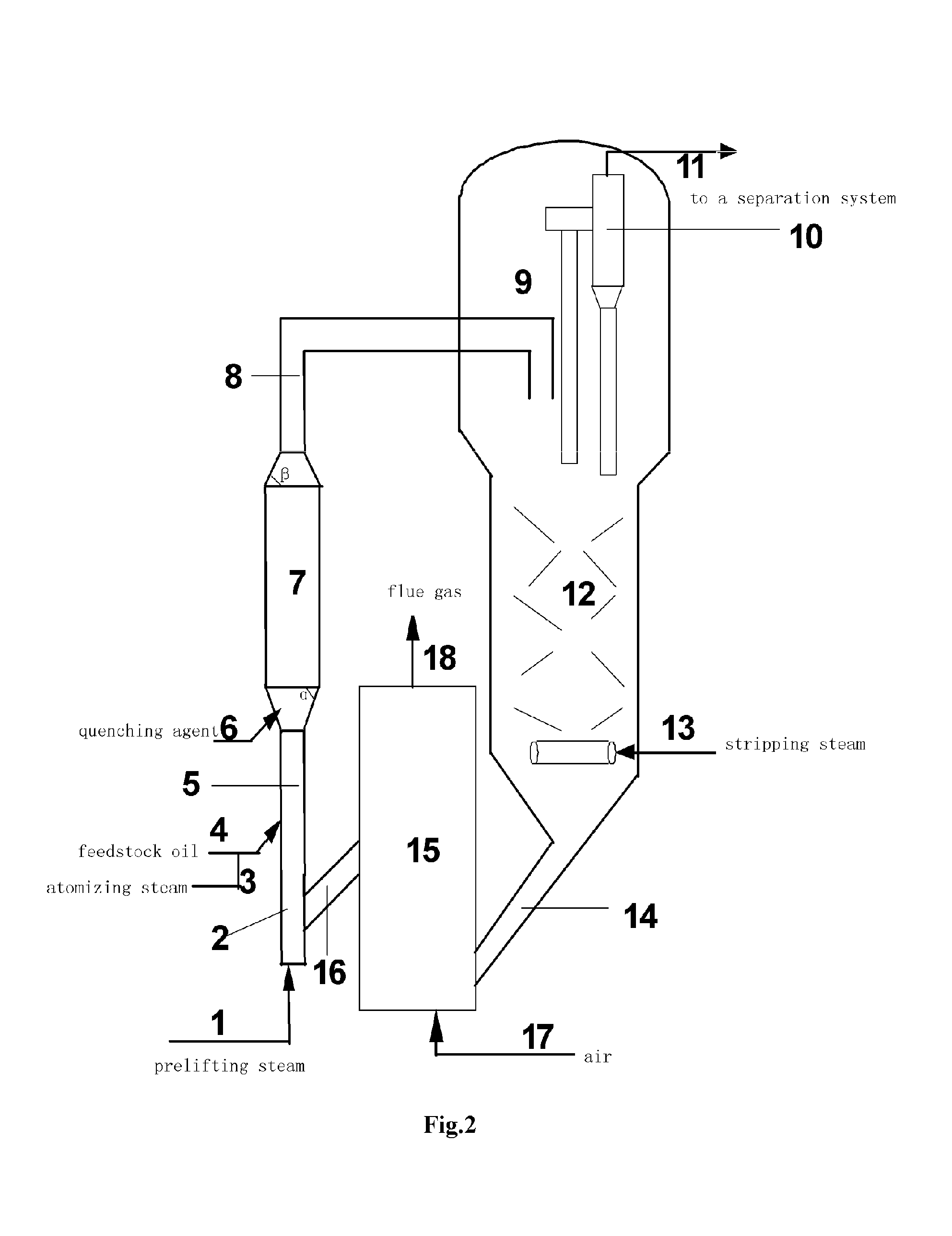Catalytic conversion method for improving product distribution
a conversion method and product technology, applied in the direction of hydrocarbon by hydrocarbon cracking, chemistry apparatus and processes, organic chemistry, etc., can solve the problems of insufficient utilization of petroleum resources and inadequate optimization of product distribution, and achieve the effects of improving product distribution, increasing the olefin content of gasoline, and increasing the isobutene content in liquefied
- Summary
- Abstract
- Description
- Claims
- Application Information
AI Technical Summary
Benefits of technology
Problems solved by technology
Method used
Image
Examples
embodiment 1
[0074]At the bottom of the conventional isodiametric riser reactor, the preheated feedstock oil contacts and cracks with a hot regenerated catalyst having a lower activity or a hot regenerated catalyst having a lower activity and a relatively homogeneous activity distribution. The resultant oil and gas and the used catalyst go upward and contact with the cooled regenerated catalyst fed therein, and subsequently the isomerization and hydrogen transfer reactions take place. After the reaction, the effluent enters the disengager. The reaction product is separated, and the spent catalyst to be regenerated is stripped, regenerated and divided into two parts, wherein one part enters the bottom of the reactor, and the other is cooled and fed into the medium and lower parts of the reactor.
embodiment 2
[0075]At the bottom of the conventional isodiametric riser reactor, the preheated feedstock oil contacts and cracks with a hot regenerated catalyst having a lower activity or a hot regenerated catalyst having a lower activity and a relatively homogeneous activity distribution. The resultant oil and gas and the used catalyst go upward and contact with a quenching agent and cooled semi-regenerated catalyst, and subsequently the isomerization and hydrogen transfer reactions take place. After the reaction, the effluent enters the disengager. The reaction product is separated, and the spent catalyst to be regenerated is stripped, fed into a two-stage regenerator and coked, wherein the semi-regenerated catalyst from the first stage regenerator is cooled and fed into the medium and lower parts of the reactor; and the regenerated catalyst from the second stage regenerator is directly fed into the bottom of the reactor without cooling.
embodiment 3
[0076]In a catalytic cracking unit having a conventional riser-fluidized bed reactor, the preheated conventional cracking feedstock is fed from the lower part of the riser and contacts with a hot regenerated catalyst having a lower activity or a hot regenerated catalyst having a lower activity and a relatively homogeneous activity distribution. The resultant oil and gas goes upward to the top of the riser, and contacts and continues to react with the cooled catalyst. After the reaction, the effluent enters the disengager. The reaction product is separated, and the spent catalyst to be regenerated is stripped, regenerated and divided into two parts, wherein one part enters the lower part of the reactor, and the other is cooled and fed into the top of the reactor.
PUM
| Property | Measurement | Unit |
|---|---|---|
| temperature | aaaaa | aaaaa |
| weight ratio | aaaaa | aaaaa |
| temperature | aaaaa | aaaaa |
Abstract
Description
Claims
Application Information
 Login to View More
Login to View More - R&D
- Intellectual Property
- Life Sciences
- Materials
- Tech Scout
- Unparalleled Data Quality
- Higher Quality Content
- 60% Fewer Hallucinations
Browse by: Latest US Patents, China's latest patents, Technical Efficacy Thesaurus, Application Domain, Technology Topic, Popular Technical Reports.
© 2025 PatSnap. All rights reserved.Legal|Privacy policy|Modern Slavery Act Transparency Statement|Sitemap|About US| Contact US: help@patsnap.com



